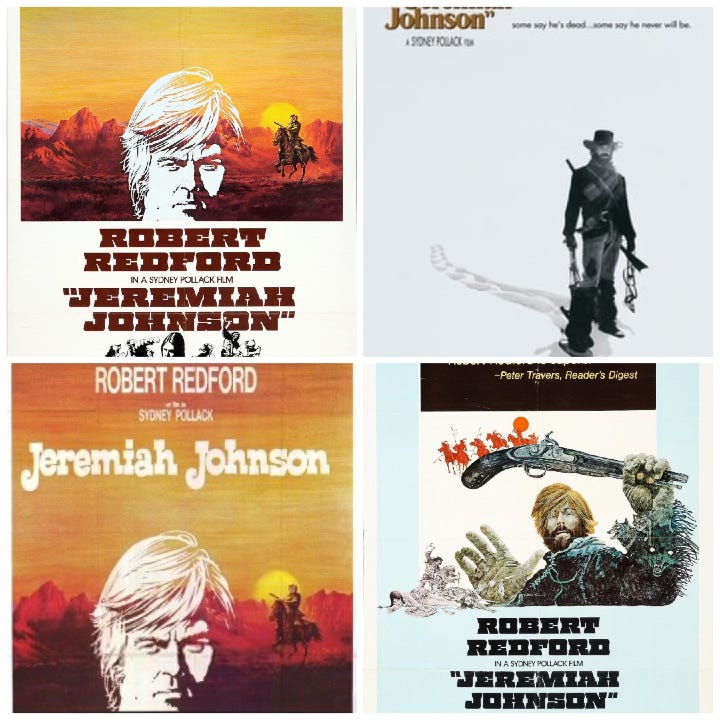70s Rewind: Robert Redford as 'Jeremiah Johnson'
Sydney Pollack directed a mountain-man adventure, rated GP.
After acting together in 1962's War Hunt -- a quite decent anti-war drama that touched on mental health issues during the Korean War -- Robert Redford and Sydney Pollack collaborated on This Property Is Condemned, an adaptation of a one-act stage play by Tennessee Williams that starred Natalie Wood. Playing her romantic interest, Redford was second-billed and acquitted himself satisfactorily, without rising above what became a so-so romantic melodrama. (Francis Ford Coppola, who made an unbilled appearance as a truck driver in War Hunt, is one of three credited screenwriters.)
Emerging actor Redford became a bonafide star in Butch Cassidy and the Sundance Kid (1969), and played a charming skier in Michael Ritchie's Downhill Racer (1969). He also appeared in Tell Them Willie Boy Is Here (1969) and Little Faus and Big Halsy (1970) before reuniting with Pollack in late 1970 to make a wilderness adventure, their second (of seven) film collaborations.
On the wonderful Warner Archive Blu-ray, which looks splendid, Sydney Pollack provides an informative audio commentary; Robert Redford provides comments on the opening and closing scenes, while writer John Milius occasion supplies occasional asides, not hesitating to point out the film's highlights and also question why some of his pages were either not filmed or didn't make the final cut (?!) The comments by Redford and Milius sound like they were recorded separately and then spliced into Pollack's commentary.
Right off the bat, I was surprised that the film begins with an orchestral overture, which I'd never seen or heard before. The film also includes an intermission at the 65-minute mark, as well as exit music. Pollack explains in the commentary that the overture, intermission, and exit music were added at the studio's request when it was decided to prepare one 70mm print, which only had an extremely limited release, perhaps at the time of the film's general release in December 1970.
Inspired by the true stories of mountain men, John Milius, then 25 or so, worked from his own extensive research to craft his screenplay, developing a style of dialogue that was not entirely authentic but sounded distinctively different. Sydney Pollack quite liked the flavor of the dialogue and Milius' writing; in the commentary, he notes that he was concerned about the dialogue and whether it could be dubbed or subtitled properly for foreign release, leading to a phone conversation with Stanley Kubrick (?!), and the beginning of a long friendship, during which they never met in person until filming Eyes Wide Shut (1999).
Robert Redford steps off a boat in the opening scene and begins his life as a mountain man, a refugee from the East who must learn how to survive in the rugged conditions of the Old West. Filming began in the winter at locations near where Redford would later buy a house and property, and near to where the Sundance Film Festival has been held for many years.
Watching the film in the wake of Robert Redford's death at the age of 89 reawakened memories of seeing him in a string of films from the late 60s through the early 80s, aka my first period of movie love. I didn't see Jeremiah Johnson until the 80s, I believe, probably on broadcast television, with advertising breaks, which undercut the rugged effectiveness of the film. My chief memory was seeing Redford trudging through the snow, and the appearance of Will Geer as a cheerful, older mountain man.
Thus, watching it on Blu-ray, it felt like a brand-new experience, which I won't spoil for anyone else by recapping the plot, which is available at a number of sites on the internet, if you're so inclined. What struck me was Redford's subtle grace in his performance, the way that he leans into the solitude that Jeremiah Johnson sought by retreating into the woods, and then how he adjusts to changing circumstances.
It's quite an arc, as they say -- including Sydney Pollack on the audio commentary -- and felt like a fitting tribute to an actor, activist, director, producer and family man who made a remarkably number of good or, at minimum, entertaining movies over his long career.
The film received a GP rating -- the successor to the M rating introduced in 1968, and one that only lasted from 1970 to 1972, before being adjusted to the much more familiar PG rating -- and makes good viewing for older children, teenagers, and adults.
The film was released in December 1972, nearly two years after production began. In the interim, Redford saw the theatrical release of crime caper The Hot Rock and the candid political drama The Candidate. Redford and Pollack next worked together on the romantic period drama The Way We Were, opposite Barbra Streisand, followed by a reunion with Paul Newman and director George Roy Hill on The Sting.
Fleeting personal encounter: The only time I saw Robert Redford in person was in the hallway of the Arclight Theaters in Hollywood after his son James Redford's directorial debut, Spin, screened at AFI Fest in November 2003. I was a seasonal worker at the fest that year; he was gathered, quietly, with his family.
We made eye contact for one or two seconds. It was electrifying (for me).


